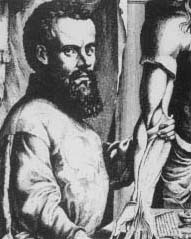Vesalius, Andreas
Andreas Vesalius (1514-1564) is widely credited with developing modern anatomical studies. Vesalius was born in Brussels, Belgium, to a family established in medicine for several generations. Young Vesalius showed an early interest in anatomy. He attended the University of Louvain, then studied medicine at the University of Paris, where he became skilled at dissection under teachers who were dedicated followers of Galen, the ancient Greek physician.

Early Career
After a working as a military surgeon, Vesalius enrolled at the University of Padua (Italy), receiving his medical degree in 1537. As soon as he became a lecturer at the university, he began to establish new ways of teaching and demonstrating anatomy. Contrary to the standard practice, Vesalius performed dissections himself during lectures and illustrated the lesson with large, detailed anatomical charts. The lectures were enormously popular and demand for the charts was so great that Vesalius had them printed.
As Vesalius proceeded with his dissections, he increasingly noted obvious conflicts between what he saw in the human body and what Galen described. Galen's errors, Vesalius reasoned, arose because the ancient anatomist relied only on animal dissections, which often did correlate to human anatomy. (Galen was not allowed to dissect human bodies because of religious restrictions.) Vesalius set down the principle that true, fundamental medical knowledge must come from human dissection, practiced by each individual physician.
Vesallus Writes a Book
To attract established physicians to the study of anatomy, Vesalius wrote one of the most important books in medical history. Published in 1543, it was the world's first textbook of anatomy called De humani corporis fabrica ("The Fabric of the Human Body"). Vesalius carefully supervised all aspects of the book's production. The Fabrica contained detailed anatomical descriptions of all parts of the human body, including directions for carrying out dissections, magnificent, detailed illustrations, probably by students from the famous painter Titian's studio, and a clear explanation of the objective, scientific method of conducting medical research.
The publication of the Fabrica rocked medicine to its foundations and was the subject of bitter controversy. For reasons not exactly clear, Vesalius abruptly quit anatomical research and became court physician to two kings. In 1564 he left Spain for a trip to the Holy Land (Palestine), perhaps intending to return to teaching in Padua. On the way back from Palestine, however, his ship was wrecked. Vesalius died on the island of Zante at the age of fifty.